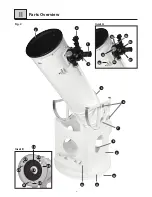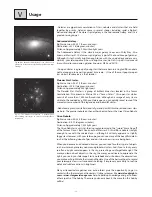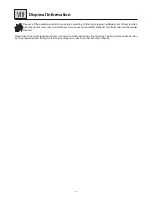
- 16 -
VI
NOTE!
Do not force the 3 screws (Fig. 22, 2) past their normal travel.
Do not rotate the collimation screws more than two full turns in a counterclockwise direction
(i.e. not more than two full turns in their "loosening" direction), or else the diagonal mirror
may become loosened from its support. NOTE: The diagonal mirror collimation adjustments
are very sensitive. In general, turning a collimation screw a half turn will have a dramatic effect
on collimation.
3. If the reflection of the diagonal mirror is not centered within the reflection of the primary
mirror, adjust the 3 collimation adjustment screws located on the rear of the primary mirror
cell.
NOTE!
The primary mirror housing (Fig. 23) is equipped with 6 screws. The 3 large knurled screws
are collimation screws (Fig. 23, 21) and the 3 smaller knurled screws are lock screws
(Fig. 23, 20). These lock screws must be loosened before the collimation screws can be
turned. Proceed by "trial and error" until you develop a feel for which collimation screw to
turn in order to change the image in any given way.
4. Perform an actual star test to confirm the accuracy of steps 1 through 3. Using the 25mm
eyepiece, point the telescope at a moderately bright (second or third magnitude) star, and
center the image in the main telescope's field of view.
5. Bring the star's image slowly in and out of focus until you see several disks surrounding
the star's center. If steps 1 through 3 were done correctly, you will see concentric (centered
with respect to each other) circles (Fig. 25, 1). An improperly collimated instrument will
reveal oblong or elongated circles (Fig. 25, 2). Adjust the 3 collimating screws on the
primary mirror housing until the circles are concentric on either side of the focus.
In summary, the adjustment screws on the diagonal mirror housing change the tilt of the
secondary mirror so that it is correctly centered in the focuser drawtube, and so that the
primary mirror appears centered when looking into the focuser. The 3 collimating knobs on
the primary mirror change the tilt of the primary mirror so that it reflects the light directly up
the center of the drawtube.
20
21
20
21
21 20
Fig. 23: Underside of rear mirror tube (primary mirror
housing). Collimation screws (20); Lock screws (21).
Fig. 22: Secondary Mirror Assembly (front and side view).
Spider vanes (1); tilt screws (2); secondary mirror holder (3).
Fig. 24: View you see while collimating the telescope
(without eyepiece inserted). Focuser drawtube (1);
diagonal mirror (2); reflection of primary mirror (3);
reflection of secondary mirror (darkened due to back
lighting) (4); primary mirror holder (5); reflection of
observer's eye (6)
Fig. 25: Correct (1) and incorrect (2) collimation as viewed
during a star test.
Maintenance and Cleaning


























